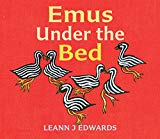The author-illustrator, Leann Edwards, is descended from the Mara/ Marra people from the Roper River (Gulf of Carpentaria) and from the Wiradjuri people of central New South Wales. In this simple and charming story, the unnamed narrator tells us about her weekly Saturday visit to Auntie Dollo's house. Auntie Dollo has a workbench full of all sorts of feathers that she has found and collected, and she uses them to make flowers. The narrator loves the variety, and the way Auntie Dollo can identify the bird that each feather came from. Auntie Dollo teaches her the traditional craft.
A subtext for the story is that like the much celebrated shell work of people on the coast, this form of folk art may disappear unless the craft is handed on from one generation to the next. In this case it is women's cultural traditions that are being kept alive, and the theme of 'Emus under the Bed' may inspire young readers from both Indigenous and non-Indigenous communities to identify and explore folk art from their own communities.
The narrator enjoys making feather flowers with Auntie Dollo, then for lunch they both enjoy damper that is being baked by Uncle Rex out in the garden. So the narrative glances at skills that are perhaps unexpected aspects of men's cultural traditions as well.
Finally, the unvoiced question posed by the title and the cover illustration emerges in the conclusion, when Auntie Dollo tells the narrator that she has a surprise for her: six emu chicks are revealed under the bed. This is a multilayered surprise. We are given no idea how the emu chicks came to be under the bed, nor what will happen to them next. So a story that started with one question - how do the title and front cover image relate to a story about flower-making? - ends with several unanswered questions. The most intriguing of those unvoiced questions is about emu feathers. The cover and the last two spreads highlight the distinctive black and white striped down of emu chicks, which is left behind as they mature into adult birds with the large grey feathers that most Australians have seen in wildlife sanctuaries or on documentary television. It is a complex image that some readers will interpret as signalling what is left behind as the years progress. We cannot hang on to everything - the striped down inevitably gives way to grey feathers as emus mature. But sometimes what is discarded can be retrieved and transformed into objects worth keeping. Although not explicit, this may be the most valuable learning that the narrator takes away from her weekly visits to Auntie Dollo's house.

